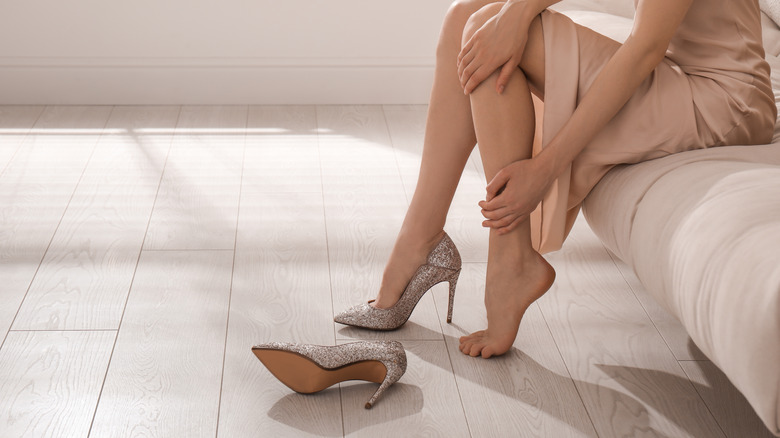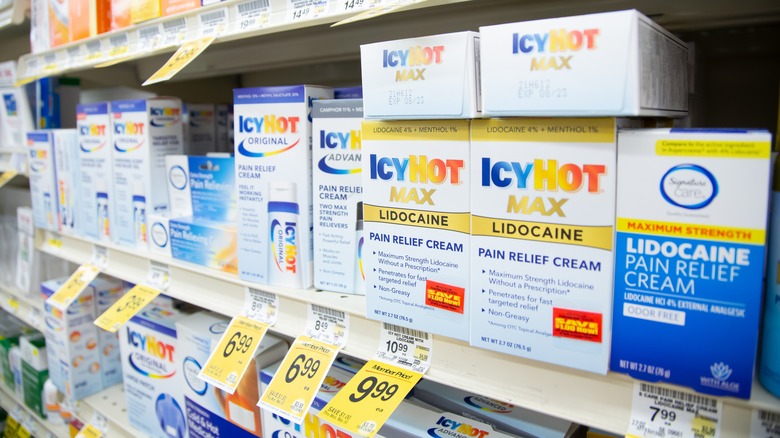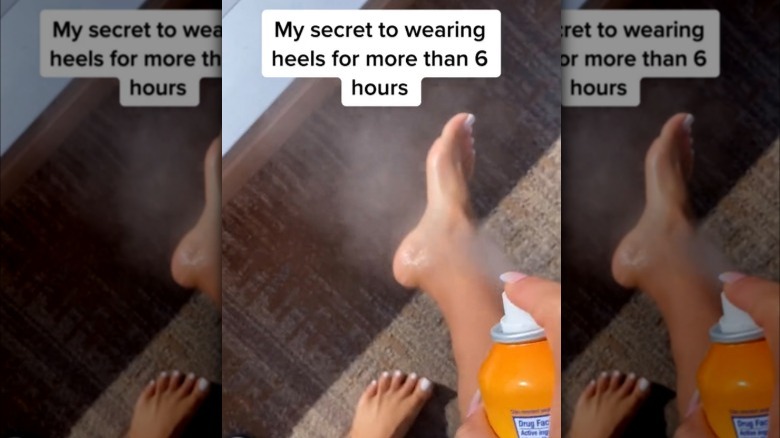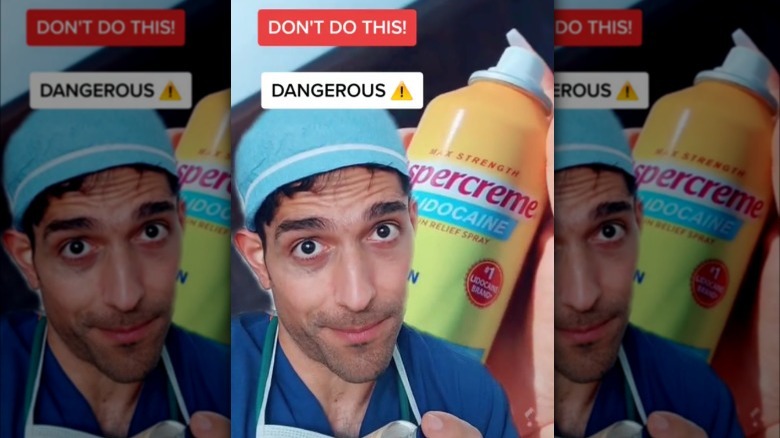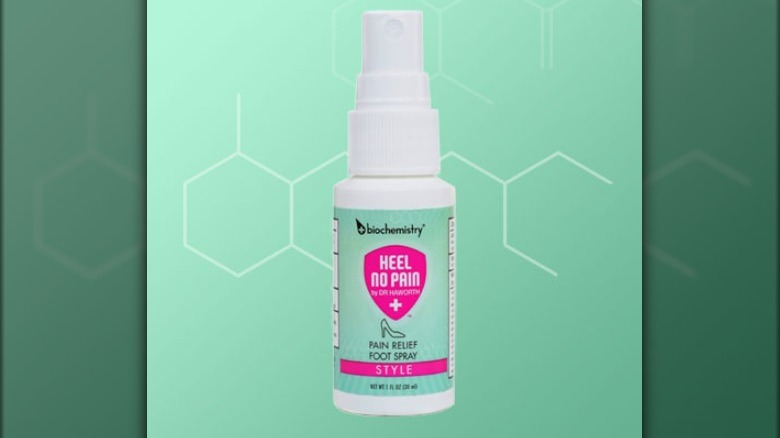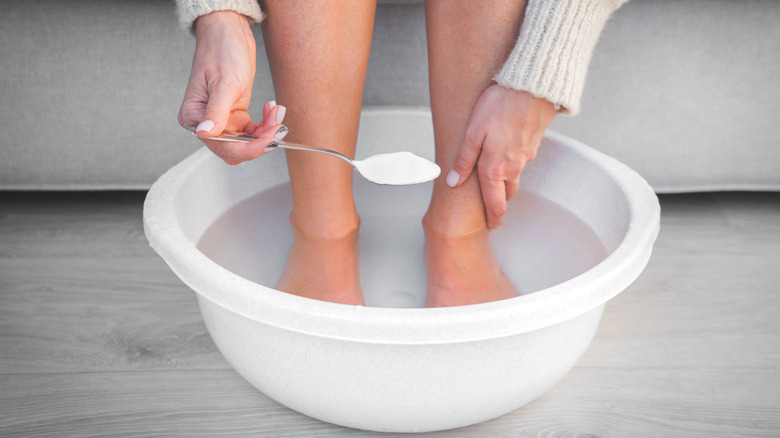Using Lidocaine To Lessen Pain From Wearing Heels Is Going Viral, But Is It Actually Safe?
We may receive a commission on purchases made from links.
Nothing elevates an outfit quite like a pair of heels. Whether you're heading into the office or a girls' night out, pairing your ensemble with a high-heeled shoe is a classy choice, especially if you're looking to elongate your legs, enhance your height, and boost your confidence.
Except, that confidence tends to go downhill after the first few hours when you go from strutting your stuff like a supermodel to looking like an infant learning how to walk. That heel pain? Ouch. While it's true that nothing elevates an outfit quite like a pair of heels, it's also true that nothing hurts the feet more. Truly a love-hate relationship.
It seems like the things we love hurt us the most (we're also talking to you, chocolate and wine), so it's no surprise social media users have come up with clever hacks to tackle life's greatest issues. For example, using lidocaine to lessen pain from wearing heels. Since there are several at-home beauty hacks you're definitely going to want to skip, you may wonder — is this one of them?
What is lidocaine?
Lidocaine is a topical anesthetic that provides temporary numbness. According to the Mayo Clinic, lidocaine works by stopping the nerves from sending pain signals to your brain, thereby leaving you with a temporary loss of feeling in the area where it is applied. It's helpful for those who experience pain, soreness, or itchiness associated with medical conditions and injuries, like sunburns, bug bites, body aches, and sore muscles. Patients who are preparing for uncomfortable or painful medical treatments may also benefit from lidocaine.
While lidocaine is available via a prescription, a trip to your local pharmacy or drugstore reveals countless over-the-counter lidocaine products as well. From patches and ointments to sprays and gels, lidocaine comes in a variety of forms and is a common product found in many medicine cabinets. If you've ever used the tried-and-true pain-relieving product Icy Hot, you've most likely encountered lidocaine, as most Icy Hot products contain the anesthetic.
What is the lidocaine heel hack?
Since lidocaine is primarily used as a numbing agent, we can see how it appears helpful in shielding the feet from painful heels. However, people aren't using it for relief after wearing the shoes — but before putting them on. The hack went viral in a TikTok video shared by @christyclips, which has racked up over 1 million likes. The video depicts a woman spraying lidocaine on her feet, with text that reads, "my secret to wearing heels for more than six hours."
The video suggests that spraying the feet with lidocaine before putting the heels on can stop or lessen the discomfort before it happens. It collected several comments, with viewers excited to try the feet-saving lidocaine hack. "I need to try this. I'm tired of taking it like a champ," the top comment reads.
Content creator @legendarylulu9 tried the hack for herself, and when a commenter asked for an update, she posted a video saying it (somewhat) worked. Moreover, she asked her pharmacist if it was safe, and she was told yes, "It's totally safe to use," as long as you don't have open sores, which can "cause an infection." Is this true?
Is the lidocaine heel hack really safe?
The hack has gone incredibly viral, with handfuls of high heel-wearing fashionistas trying it out and sharing their experiences on social media. This prompted Dr. Anthony Kaveh, an anesthesiologist who provides medical education on TikTok, to post a video sharing his thoughts on the viral hack. "Don't do this!" the text on his video reads. "Not only is it minimally effective, but also super dangerous," he says in the video. "Especially if you are diabetic or have any nerve problems."
He further explained in the comments that people with diabetes are "prone to loss of sensation, festering wounds they can't see or feel, and life-threatening infections needing amputation." Therefore, if you already have difficulty feeling sensations, you may want to avoid further complications. Not only that, but pain is the body's way of letting you know something is amiss. Completely cutting off that pain and continuing the thing causing it (aka the heels) may make that pain greater.
Podiatrist Dr. Nicole Nicolosi agrees. She told the Cleveland Clinic, "Let's say your shoe is rubbing wrong and creating a blister. Normally, you'd stop what you were doing if you felt it happening," she said. "But if you numbed your foot, that signal is off — and you might end up making a small problem worse. It's not a good idea."
A foot-numbing spray hit the shelves nearly ten years ago, and even then, it was controversial
It turns out this lidocaine heel hack isn't completely new. In 2013, ABC News published an article regarding a foot-numbing spray called Heel No Pain, produced by plastic surgeon Dr. Randal Haworth and set to hit the shelves in 2014. The main ingredient? Lidocaine.
This spray was designed to be applied a handful of times throughout the day to ease heel pain as necessary. And even then, some doctors were concerned. "It's not really curing a problem. It's really just masking the pain," Dr. Jaime Hernandez, a Southern California-based orthopedic surgeon, told ABC News. "It's important to listen and receive any signals the body is sending to you."
The product is still available for purchase today. A similar version of the product called Still Standing is a "natural" version of the lidocaine spray, which has received 3.7 out of five stars on Amazon. This product is not intended to numb the feet. Instead, it is infused with aloe, menthol, and tea tree oil, among other natural ingredients, to "prevent" swollen feet, which is said to lessen the pain.
If your heels are always hurting you, try going up a size
When it comes to the feet, sizing up may be a great idea so that your feet have room to breathe if they swell. According to Harvard Health, the feet naturally swell as the day goes on, so it may be beneficial to heel shop in the afternoon or evening to get an accurate idea of how the shoes will fit.
Like everything in fashion, the most important aspect is mental and physical comfort — not the size of the item. If you cringe at the thought of going up sizes, you aren't alone. Remind yourself that your comfort is most important, and size is just a number. Also, try not to be so in love at first sight with the heel that you fail to give them a solid try-on. Strut around the store with the heels on to see how they feel.
If they're too tight and already hurt your feet after five minutes, go up a size. Try going up half a size if the heel is three-and-a-half inches or less. If the heel is up to six inches high, size up one full size. And for heels over six inches (you better work!), try going up one and a half sizes.
Other remedies to prevent and treat foot pain from heels
When wearing your gorgeous pair of heels, take it easy. Don't be afraid to sit when you can, and rest your feet when necessary. If you know you'll be on your feet for extended periods, try opting for a shorter heel and reach for your comfiest pair. Shoes with a thicker heel, like wedges, are excellent options for those who want the benefits of a heel without the pain.
When you remove your heels, you may notice a bit of tension, soreness, and maybe even painful blisters. What we endure to look good, right? You'll first want to stretch your feet and loosen them up. Then, give yourself a relaxing spa experience with a warm Epsom salt-infused soak. If you have any open sores from the blisters, don't forget to pop on some ointment, like petroleum jelly, to help them heal.
Try to stay off your feet and avoid wearing painful high heels again for a few days. If you can't stay away from elevating your outfits to new heights with a pair of heels, we don't blame you. But, as tempting as it is, you may want to play it safe and refrain from reaching for the lidocaine.
